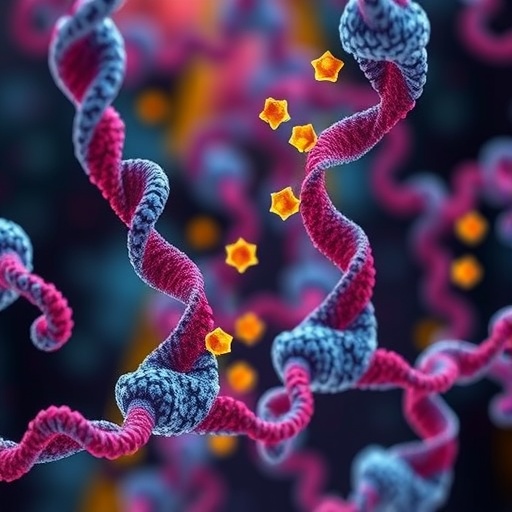In an era where personalized medicine stands at the forefront of biomedical innovation, the intricate relationship between our genetic architecture and the social environment is rapidly transforming our understanding of human health. A groundbreaking study recently published in Cell Death Discovery by Caporali, Russo, Leist, and colleagues delves deeply into this multifaceted interplay, weaving together epigenetic mechanisms and social determinants to chart an ambitious path from molecular biology to precision medicine. This comprehensive research offers compelling insights into how environmental factors modulate gene expression, thereby reshaping the traditional paradigms of disease susceptibility and therapeutic interventions.
The intersection of genetics and social context is no longer a peripheral consideration but a central theme in deciphering disease etiology. The study underscores the profound ways in which social environments, encompassing stress, socioeconomic status, and social support networks, exert epigenetic influences that dynamically alter chromatin states and gene regulatory landscapes. Central to this discourse is the role of DNA methylation, histone modifications, and non-coding RNAs—all pivotal epigenetic actors that orchestrate gene expression without altering the DNA sequence itself. By meticulously charting these modifications, the authors illuminate how external social cues transcend mere biochemical reactions to imprint lasting biological effects.
Epigenetics, often described as the bridge between nature and nurture, emerges as the linchpin in the study’s exploration of precision medicine. The authors argue that epigenetic signatures shaped by social experiences can serve as biomolecular footprints, predicting individual disease trajectories and responsiveness to therapies. For instance, chronic social stress is shown to induce persistent epigenetic changes that influence neuroendocrine functions and immune responses, thereby modulating vulnerability to conditions like depression, cardiovascular disease, and autoimmune disorders. This revelation challenges the reductionist view of genetics as determinative, emphasizing instead a fluid genomic responsiveness to environmental stimuli.
.adsslot_nNQapJFmWB{ width:728px !important; height:90px !important; }
@media (max-width:1199px) { .adsslot_nNQapJFmWB{ width:468px !important; height:60px !important; } }
@media (max-width:767px) { .adsslot_nNQapJFmWB{ width:320px !important; height:50px !important; } }
ADVERTISEMENT
One particularly striking aspect of the study is its layered analysis of how socioeconomic status (SES) imprints on the epigenome. Lower SES, often synonymous with higher chronic stress, food insecurity, and limited access to healthcare, is implicated in epigenetic dysregulation that predisposes individuals to metabolic syndrome and inflammation-related diseases. By integrating epidemiological data with epigenomic profiling, the authors elucidate mechanistic pathways whereby social adversity translates into molecular risk factors. This hyper-focused examination advances the field beyond correlation, offering causal explanations grounded in biochemical processes.
The research also opens new vistas in understanding the temporal dynamics of epigenetic modifications driven by social environments. The team highlights that early-life experiences, especially during critical developmental windows, wield disproportionate influence on epigenetic landscapes. Prenatal exposure to maternal stress or malnutrition, for example, triggers alterations in DNA methylation patterns that can persist throughout life, predisposing offspring to a spectrum of non-communicable diseases. These findings echo the developmental origins of health and disease (DOHaD) hypothesis but are now enriched by high-resolution epigenetic data.
Moreover, the authors navigate beyond the nucleus to consider the role of epigenetic changes in peripheral tissues and their systemic implications. For instance, epigenetic reprogramming in immune cells, induced by social stressors, modulates the inflammatory milieu, linking psychosocial experiences with somatic health. This crosstalk between immune modulation and gene-environment interplay underpins a growing recognition of psychoneuroimmunology as a fertile terrain for therapeutic innovation in precision medicine.
Technological advances have propelled epigenetic research into precision realms, and the study leverages cutting-edge genomic tools such as single-cell epigenomics and CRISPR-based epigenetic editing to unravel cell-type-specific modifications. By dissecting epigenetic heterogeneity in different cellular compartments, the authors demonstrate that social environment impacts are not monolithic but rather finely tuned. This nuanced perspective elevates precision medicine strategies, advocating for individualized epigenetic profiles as indispensable biomarkers for diagnosis and treatment stratification.
Crucially, the study also confronts the challenges of integrating complex social variables into molecular research. It advocates for multidisciplinary frameworks combining sociology, molecular biology, and bioinformatics to decode the multilayered gene-social environment nexus. The authors stress the importance of large-scale longitudinal cohort studies enriched with detailed social and environmental data to validate epigenetic findings in diverse populations, thereby enhancing the reproducibility and clinical relevance of the research.
From a therapeutic vantage point, the paper envisions novel interventions targeting the epigenome—epidrugs designed to reverse maladaptive modifications wrought by adverse social exposures. Histone deacetylase inhibitors, DNA methyltransferase inhibitors, and emerging RNA-based therapeutics hold promise to recalibrate epigenetic states, offering new hope for conditions previously deemed intractable. However, the authors caution that such strategies require precision tailoring to avoid off-target effects and unintended consequences, underscoring the imperative for robust epigenetic biomarkers.
Ethical considerations also permeate the discourse, particularly regarding the implications of identifying social environment-induced epigenetic changes. The potential stigmatization or misinterpretation of epigenetic marks as deterministic markers of social disadvantage underscores the delicate balance between scientific advancement and social justice. The authors advocate for responsible communication and equitable healthcare policies that translate epigenetic insights into benefits for marginalized populations without exacerbating disparities.
Beyond individual health, the study hints at population-level interventions informed by epigenetic epidemiology. By pinpointing societal factors that engender adverse epigenetic signatures, public health strategies can be devised to ameliorate social conditions, thereby preempting disease onset at its molecular roots. This approach exemplifies a transformative vision where precision medicine extends its reach from individualized therapy to societal well-being.
In considering future directions, the research calls for enhanced computational models capable of integrating multi-omics data layers—including genomics, epigenomics, transcriptomics, and exposomics—with social and behavioral metrics. Artificial intelligence and machine learning stand poised to unravel complex interaction networks, facilitating predictive analytics that inform personalized prevention and intervention paradigms.
Furthermore, the authors speculate on the role of transgenerational epigenetic inheritance in perpetuating the biological effects of social environments. While still a nascent field, evidence suggests that epigenetic marks influenced by ancestral experiences may impact descendants’ health, adding a generational dimension to the gene-environment dialogue. This compelling notion broadens the scope of precision medicine and social epidemiology alike.
The integration of environmental ‘omics’ with social determinants heralds a paradigm shift in biomedicine. By charting the path from epigenetic modifications to clinical phenotypes within complex social matrices, Caporali and colleagues’ study offers a visionary blueprint. It exemplifies how molecular insights combined with social awareness can pave the way for innovative healthcare tailored not only to individual genomes but also to the intricate social tapestries that shape human biology.
Ultimately, this pioneering research invites a reevaluation of health and disease through an epigenetic lens that honors the dynamic reciprocity between genes and the social environment. The findings ignite optimism that by decoding and manipulating these molecular signatures, medicine can transcend traditional boundaries, ushering in an era where social justice and biological precision converge to enhance human well-being.
Subject of Research: Interactions between genetic/epigenetic mechanisms and social environment influences, with applications toward precision medicine.
Article Title: Interplay between genes and social environment: from epigenetics to precision medicine.
Article References:
Caporali, S., Russo, S., Leist, M. et al. Interplay between genes and social environment: from epigenetics to precision medicine. Cell Death Discov. 11, 293 (2025). https://doi.org/10.1038/s41420-025-02580-z
Image Credits: AI Generated
DOI: https://doi.org/10.1038/s41420-025-02580-z
Tags: chromatin states and disease susceptibilityDNA methylation effectsepigenetic mechanisms in diseasegene expression and environmenthistone modifications in healthinterdisciplinary approaches in biomedical researchnon-coding RNAs and gene regulationPersonalized Medicineprecision medicine innovationssocial determinants of healthsocial stress and health outcomessocioeconomic status and genetics





